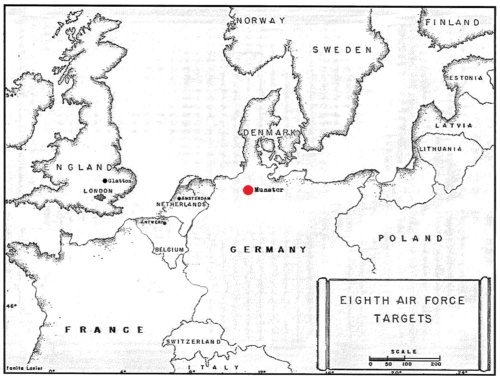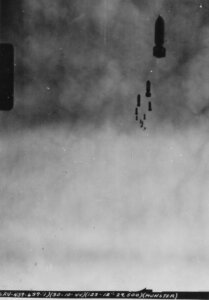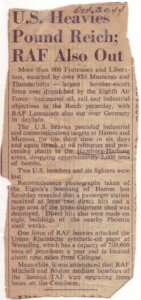TARGET: MARSHALLING YARDS
MUNSTER, GERMANY
30 OCTOBER, 1944

Although the assigned primary target was the synthetic oil plant at Gelsenkirchen, solid undercast caused the Group to bomb Munster for the second time in three days. The 457th comprised the 94th B Combat Wing, with Lt. Col. Francis as Air Commander.
The Group assembled and flew the Division Assembly line as briefed and in proper position. Some difficulty was encountered in maintaining Division formation when the Group ran into very dense and persistent contrails west of the Dutch coast. However, the course to the IP was flown as briefed.
Since ten-tenths clouds covered the primary target, the Group attacked the PFF secondary target. The turn was made at the IP, as briefed for PFF bombing, with squadrons in trail. Visibility was poor because of contrails. Meager and inaccurate flak had no effect on the bomb run. The lead squadron performed its own sighting and released its bombs from 28,000 feet. The high squadron also performed its own sighting. The PFF equipment malfunctioned halfway down the bomb run, but the operator had given a sufficient number of dropping angles to permit the bombardier to release bombs. The low squadron dropped on the smoke markers of the lead.
Target Munster, Germany
The route from the target was flown as briefed. All planes returned safely to the base with two craft sustaining damage. Weather had limited the bombing operations and October ended with the Group having flown only 13 missions, the same as in September, and ranking with September as the smallest i number since February. However, in terms of effort, the Group matched September and every other month. It had also suffered a devastating blow on the Politz mission.
High pressure was still on the crews. As an example, Spleth’s crew flew its first mission on September 12. Starting then, the Group flew 22 missions by the end of October; the crew had launched on 20 of them. More crews were badly needed.
30 October was Monday. Little did the Group realize that before week’s end, another deadly air battle was to be fought over the skies of Germany.
Sgt. Albert G. Williams, 457th/751st gunner: Got out of the sack at 0600. Bomber Munster with P.F.F. It was a Milk Run Bombing altitude was 29,500 feet and was a minus 50 degrees over target. Bomb load consisted of 18 – 264 lb. G.P’s ETR was 1300



